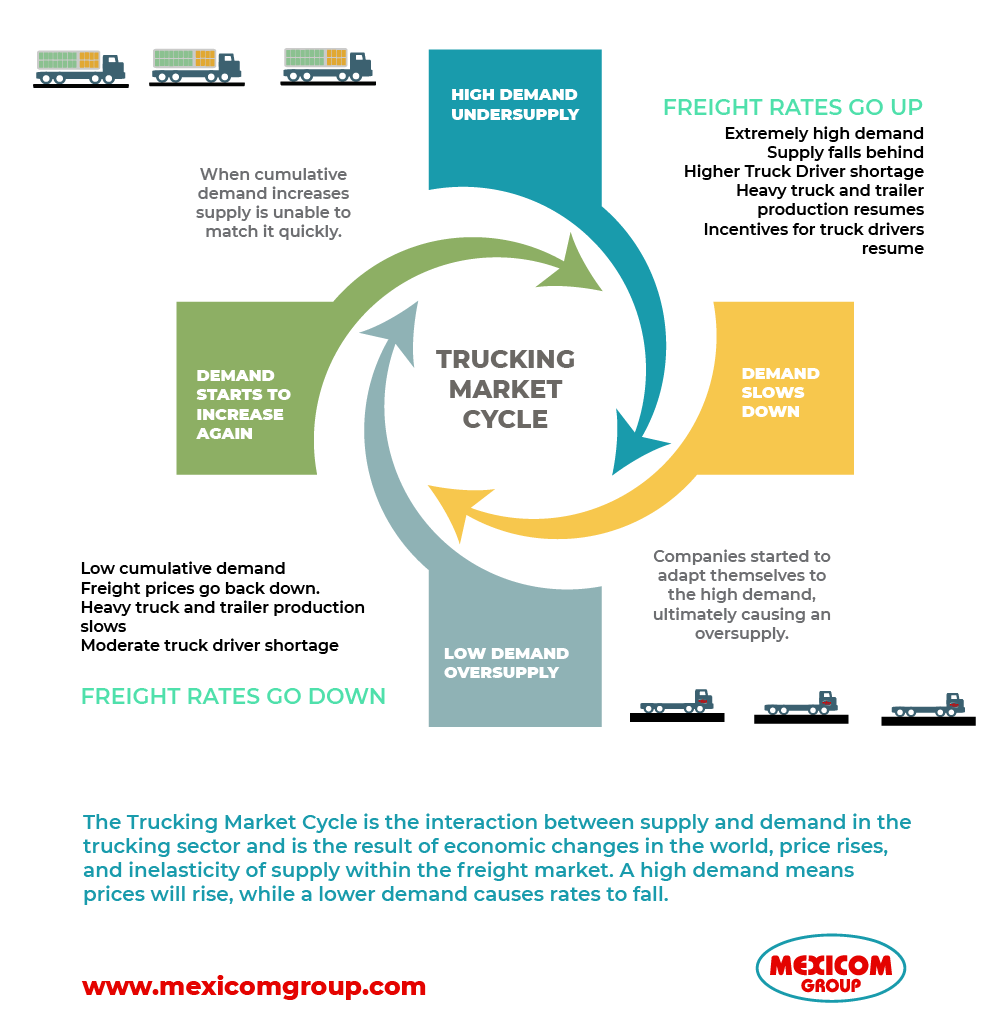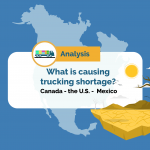[Infographic] What is the Ground Freight Market Cycle in North America?
The Trucking Market Cycle is the interaction between supply and demand in the trucking sector and is the result of economic changes in the world, price rises, and inelasticity of supply within the freight market. High demand means prices will rise, while a lower demand causes rates to fall.

HIGH DEMAND – UNDERSUPPLY
When cumulative demand increases supply is unable to match it quickly.
As demand increases and more trucking services are needed, the supply can not be adjusted quickly, because freight companies are already managing existing demand. Then freight prices increase. And the building supply process restarts.
- Extremely high demand for trucking services
- Supply falls behind
- Higher Truck Driver shortage
- Heavy truck and trailer production resumes
- Incentives for truck drivers resume
- Freight rates go up
DEMAND SLOWS DOWN
Companies started to adapt themselves to the high demand, ultimately causing an oversupply.
LOW DEMAND – OVERSUPPLY
- Low cumulative demand
- Freight prices go back down.
- Heavy truck and trailer production slows
- Moderate truck driver shortage
DEMAND STARTS TO INCREASE AGAIN
When freight rates are low, the freight equipment availability goes down causing an undersupply.
The business cycle and the Trucking Market Cycle could be linked because decreases in aggregate demand will mean lower demand for trucking services. However, the Trucking Market Cycle has proven to be shorter than the business cycle. In North America, actors in the trucking industry are accustomed to the volatility of the demand, supply, and rates and have learned to adapt quickly to change. Therefore, the recovery periods of the Trucking Market Cycle are shorter than the broader economic cycles.
Also, the changes in the Trucking Market Cycle are a result of several factors specific to the industry and to the particular region where the Ground Freigth Market is analyzed.
Two Particularities of the Trucking Market across North American Borders
The demand for northbound ground freight shipments has been increasing since 1995
U.S goods trade Mexico has had a deficit since 1995 and it has increased over the years. In 2021, the U.S. trade goods deficit with Mexico was -108 246,6 million U.S. dollars, while in 2001, it was -30, 041 million US dollars. Since most goods in North America are moved by truck, this means that the demand for northbound freight shipments has been increasing without stopping. In consequence, most of the time there is an undersupply of freight equipment to satisfy the growing demand.

There is a permanent shortage of truck drivers
Even when the Trucking Market Cycle changes phases, in North America, there is a problem that persists: the Truck Driver shortage. For different reasons, such as wages, work conditions, millennial’s lifestyle and job expectations, high risks on the road, retirement, vaccine mandates, the pandemic, etc. there has been a shortage of truck drivers in Northamerica that has been aggravated in the last years and continues to increase. This affects the overall trucking supply in the Market Cycle. Even when the Cycles point toward a balance or a lower demand, the problem of driver shortage remains.
There are other factors affecting the Trucking Market Cycle in North America, such as the historical increase in fuel prices, and inflation along with the impact of the Ukraine crisis.
Sources:
[https://www.census.gov/foreign-trade/balance/c2010.html]
[https://convoy.com/blog/freight-industry-recessions-and-the-business-cycle/]
Graphics attribution
<a href=’https://www.freepik.com/vectors/cycle-chart’>Cycle chart vector created by katemangostar – www.freepik.com</a>


![[Infographic] What is the Ground Freight Market Cycle in North America? [Infographic] What is the Ground Freight Market Cycle in North America?](https://mexicomlogistics.com/wp-content/uploads/bfi_thumb/dummy-transparent-rg1talopm5vqzufhfknfekzf15cxqqaozt80fj4ud4.png)







Muy buen artículo Marben, gracias.
Thank you for your contribution!
This is a very useful and helpful blog.
Amazing piece of Article. thank you for this.
Did not know there was a permanent shortage of truck drivers. Still some time untill the robot trucks take over.